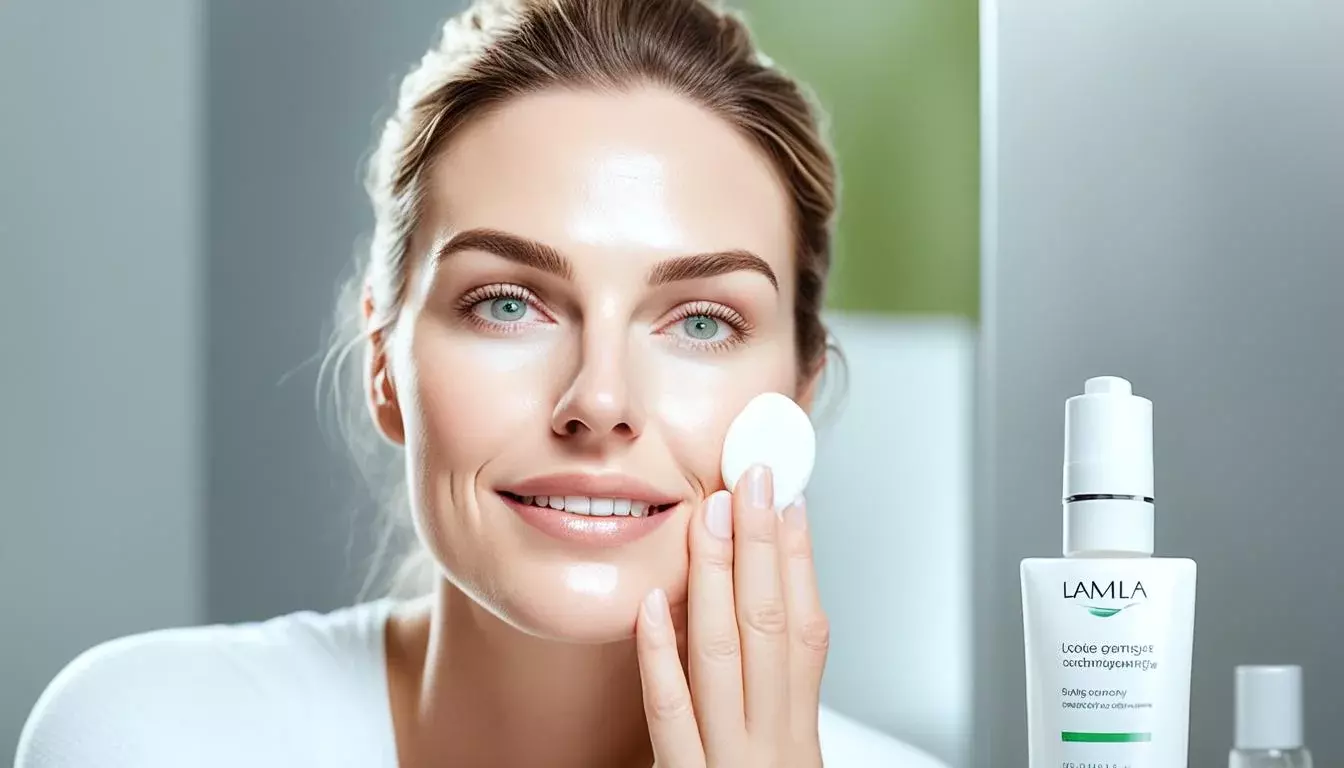Having oily skin can be challenging, but knowing how to use moisturizer for oily skin correctly helps. For women with oily skin, learn how to apply a hydrating moisturizer. We will show you helpful moisturizer application tips for oily skin.
It’s not just about picking the right products for oily skin; it’s also about how you use them. Moisturizing well can help keep oil under control and stop breakouts. Keep reading to learn how to upgrade your skincare and get more precise, healthier skin.
Understanding Oily Skin
Oily skin can be challenging to handle. But once you know its features and eliminate myths, it’s easier. This part discusses oily skin traits and skincare myths that need to be ignored.
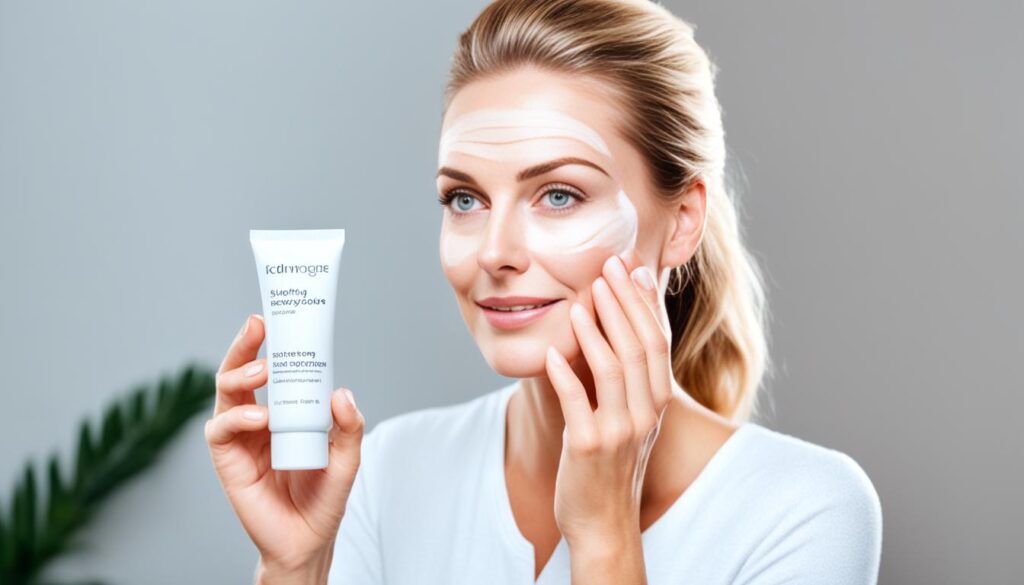
Characteristics of Oily Skin
People with oily skin look for specific things. Knowing these can help create the best skincare routine. Here are some signs of oily skin:
- Enlarged pores: They make your skin look uneven and can easily get clogged.
- Shiny complexion: There’s a visible brightness, especially on the forehead, nose, and chin, due to excess oil.
- Frequent breakouts: This skin type is prone to acne and blackheads because of overactive oil glands.
Common Myths About Oily Skin
Some myths about oily skin might confuse you. Clearing these up can change how you take care of your skin:
- Myth: Oily skin doesn’t need moisturizing. Fact: Every skin type requires moisture to stay healthy. Not moisturizing can make your skin produce more oil.
- Myth: Only teenagers have oily skin. Fact: Adults can also battle oily skin, often due to hormones, stress, and family traits.
- Myth: You should use harsh products to strip away oil. Fact: Strong products can harm your skin and cause it to produce more oil as a protective response.
Understanding oily skin and skipping the wrong advice can help you deal with it. It’s all about choosing the right products and knowing what to do.
Choosing the Right Moisturizer for Oily Skin
It can be hard to find the best moisturizer for oily skin. But it’s vital to keeping your skin looking great. The perfect moisturizer will manage oil and prevent acne. Let’s learn how to pick the right one for you.
Oil-Free and Non-Comedogenic Options
Look for moisturizers that are oil-free and non-comedogenic. An oil-control moisturizer soaks up extra oil, giving you a fresh look all day. And a non-comedogenic moisturizer won’t clog your pores, helping to avoid pimples and blackheads. Neutrogena, Cetaphil, and La Roche-Posay are top picks in this area.
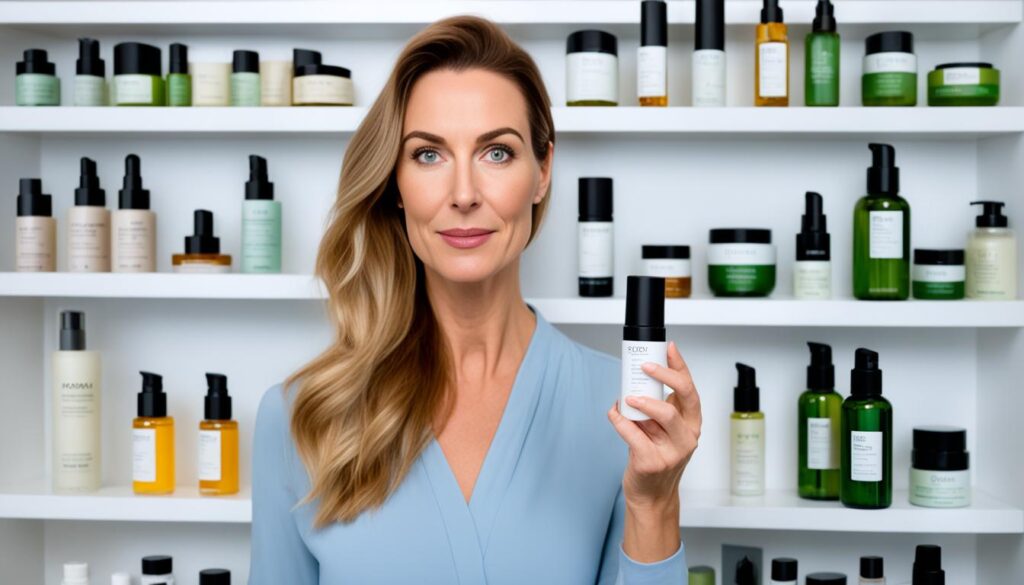
Ingredients to Look For
Moisturizer ingredients can make a big difference in how well they work. Here are some important ones to check for:
- Hyaluronic Acid: Hyaluronic acid deeply hydrates without making skin oily. It also keeps skin looking full without clogging pores.
- Salicylic Acid: Salicylic acid is excellent for fighting acne. It clears skin by removing dead cells and unclogging pores.
- Niacinamide: Niacinamide helps tone down oil and reduce redness, making it an excellent choice for oily, acne-prone skin.
Ingredients to Avoid
Avoiding certain ingredients is crucial for oily skin. They can make oiliness worse and lead to breakouts:
- Mineral Oils: Mineral oils can layer on the skin, trapping bacteria and causing acne.
- Fragrances: Scents in products can irritate and increase breakouts. Go for options without added fragrance.
- Alcohol-Based Ingredients: These ingredients might seem to dry skin, but they can provoke more oil production.
Choosing the proper skin care is vital for healthy, non-greasy skin. The perfect oil-control moisturizer and non-comedogenic moisturizer are game-changers for your daily skincare.
Hydrating Lotion for Oily Skin
Looking for the right hydrating moisturizer for oily skin can be a challenge. You want a product that does two things well: keeps your skin moist and feels light. An excellent lightweight moisturizer for oily skin will keep your skin balanced, not oily.
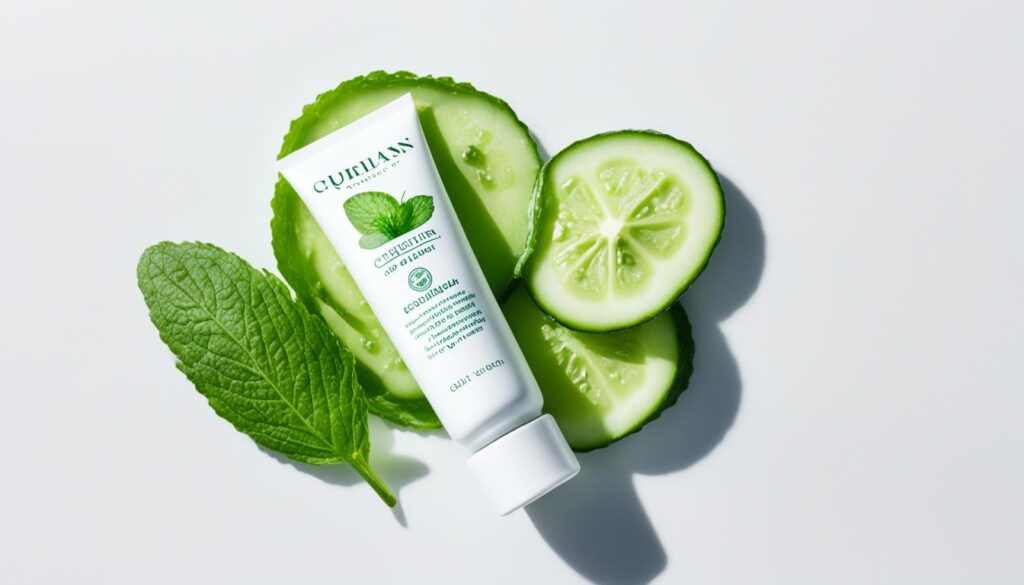
The top hydrating lotions are lightweight and easy to absorb, perfect for daily care. They are made with ingredients that hydrate but don’t block pores, making them excellent for oily skin.
It is an excellent hydrating moisturizer for oily skin that doesn’t contain oils. It keeps your skin hydrated without making it look or feel greasy. Using a lotion for oily skin can keep your face looking and feeling good all day.
| Feature | Benefit |
|---|---|
| Lightweight & Fast-Absorbing | It prevents a greasy feeling and promotes quicker application |
| Oil-Free Formulation | Maintains hydration without clogging pores |
| Daily Use Compatibility | Ideal for maintaining consistent skin moisture |
Choosing a lightweight moisturizer for oily skin is vital. It ensures your beauty routine supports your skin’s health. Look for products that balance moisture and control oil. This will help your skin look its best.
Why Moisturizing is Important for Oily Skin
People with oily skin may avoid moisturizer, thinking it will make their skin greasier. But, such thinking is not correct. Moisturizing can help their skin. By doing so, they can balance the oil, leading to healthier skin.

Balancing Oil Production
Moisturizing for oily skin helps balance oil production. Dehydrated skin produces more oil. So, keeping your skin hydrated will reduce oil production. It’s crucial to pick a moisturizer that hydrates well but doesn’t make your skin too oily.
Preventing Breakouts
Moisturizing also helps prevent acne. Dry skin can cause your body to overproduce oil, leading to clogged pores. The right moisturizer forms a barrier on the skin, stopping bacteria and acne. Dermatologists stress the importance of moisturizing to manage oily skin and reduce breakouts.
| Benefits of Moisturizing | Impact on Oily Skin |
|---|---|
| Balances Oil Production | Prevents excessive oiliness |
| Prevents Breakouts | Reduces risk of acne |
| Maintains Hydration | Keeps skin soft and smooth |
When to Apply Moisturizer for Optimal Benefits
Figuring out the best time to apply moisturizer makes it work better. Try using a morning and night skincare routine, which boosts the effects of your moisturizer.
Morning vs. Evening Application
Putting on moisturizer in the morning prepares your skin for the day. It shields your skin from UV rays, pollution, and rough weather and helps keep it hydrated all day.
At night, moisturizer focuses on repairing and nourishing your skin. During sleep, your skin naturally repairs itself. A good night moisturizer boosts this process, helping your skin cells renew and heal while you rest.
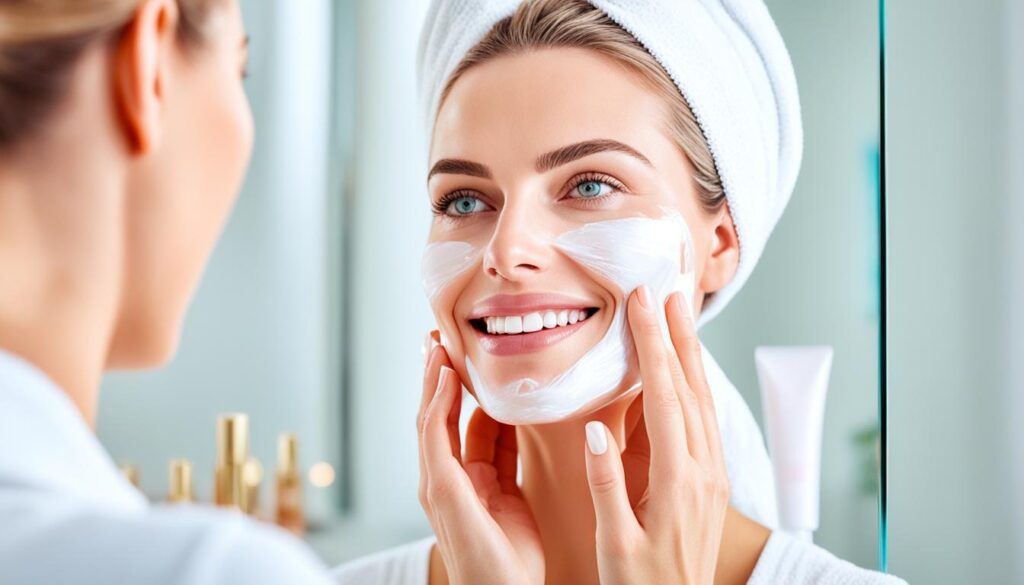
It’s critical to know what each routine does. In the morning, use a light moisturizer under makeup. Use a thicker moisturizer at night to deeply hydrate your skin as you sleep.
How to Properly Cleanse Before Moisturizing
Start your skincare routine with a clean face. A good cleanse ensures your skin is free from dirt, making it easier for your skin to soak up the moisturizer’s goodness. We’ll help you pick the best cleaner and show you how to clean well.
Choosing the Right Cleanser
If your skin is oily, choose gentle cleansers. Strong cleaners can make your skin produce more oil. Find products that say “non-comedogenic” and “oil-free” to keep your pores clear.
Steps for Effective Cleansing
- Start with clean hands to keep bacteria off your face.
- Warm your face with lukewarm water to open your pores.
- Use a little cleanser and gently rub it in, especially on oily areas like the T-zone.
- Finally, rinse well with lukewarm water to wash away the cleanser and dirt.
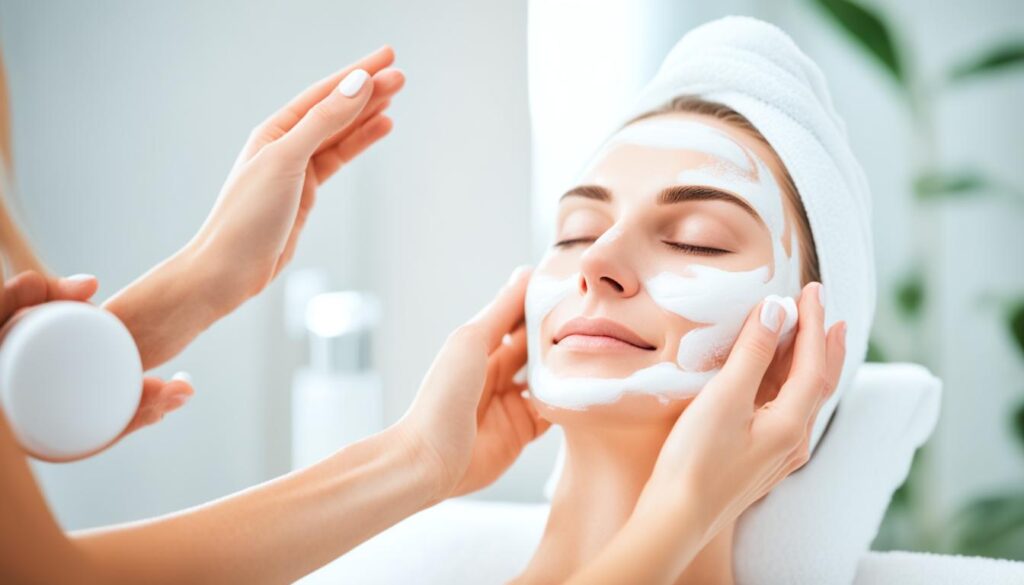
Importance of Patting Dry
Don’t rub your face dry after cleaning. Just pat it gently with a soft towel. This facial cleansing technique helps keep your skin’s natural protection strong. Patting also helps keep your skin moist, helping your moisturizer work better.
Steps to Properly Apply Moisturizer for Oily Skin
Applying moisturizer the right way is critical for balanced skin, especially if it’s oily. The proper techniques ensure your skin gets the most out of your moisturizer. We’ll look at essential tips for putting on moisturizer.
Cleansing Your Skin
The first thing you should do is clean your face well. Pick a gentle, oil-free cleanser to remove dirt and extra oil. This keeps your skin’s natural moisture. Your face will be fresh and ready for the next steps of your routine. Cleanse both in the morning and at night for the best outcome.
Using a Toner
After cleaning your skin, reach for an oil-free toner for oily skin. This balances your skin’s natural oils and prepares it for moisturizing. The best toners for oily skin help reduce oil and shrink pores without drying your skin out.
Using the Right Amount
For oily skin, it’s better to use a little moisturizer. Too much can make your skin feel and look more oily. A pea-sized drop should cover your whole face. This way, your skin stays moist, not oily.
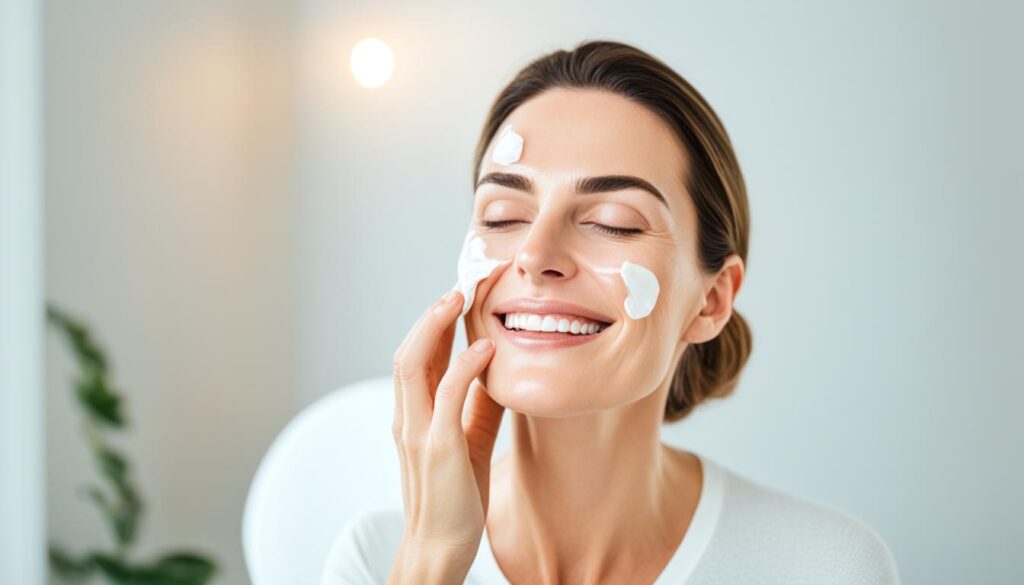
Application Methods
How you put on moisturizer matters a lot. Let’s go through some handy moisturizer application methods:
- Dot Method: After cleansing, apply moisturizer to your forehead, cheeks, nose, and chin. Softly pull it outwards using upward motions.
- Press and Pat: Instead of rubbing, pat the moisturizer gently onto your face. This helps your skin soak it up better, minus extra oil.
- Use Clean Hands: Make sure your hands are clean when using moisturizer. Dirty hands can cause breakouts by adding bacteria to your skin.
Adding these beauty techniques to your daily plan will keep your skin glowing and oil-free. The proper moisturizer application methods lay the groundwork for a radiant face without shine.
Moisturizing During Different Seasons
Your seasonal skincare routine can be tricky, especially for those with oily skin. Each season comes with its skin obstacles and needs for balance. Adjusting your moisturizer and how you use it as the seasons change is essential.
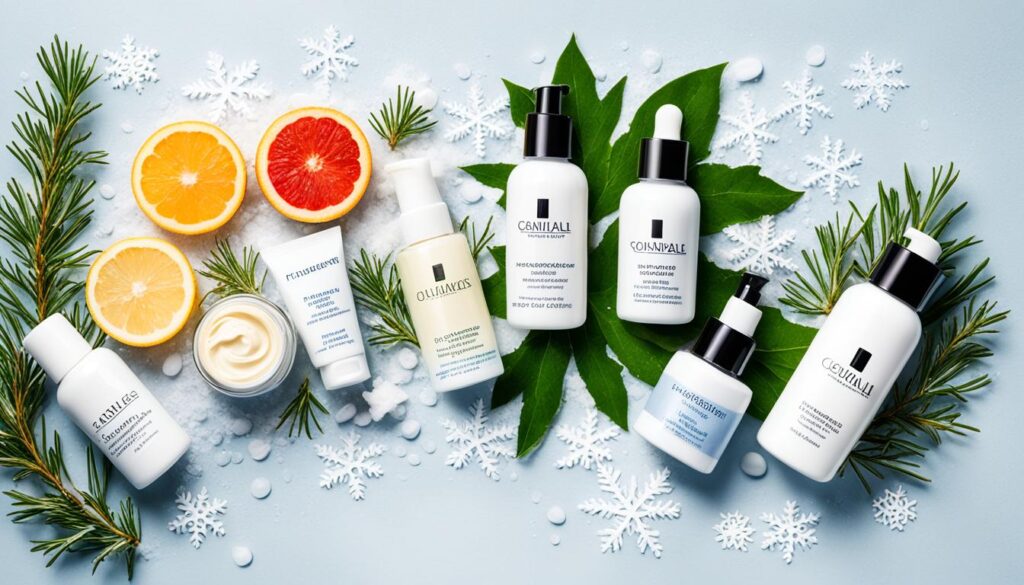
Summer Care for Oily Skin
In summer, the heat and humidity can make oily skin more noticeable. Use light, water-based, or gel moisturizers for summer care. These will give you the moisture you need without feeling greasy. Don’t forget to add high SPF to protect your skin from the sun.
“The sweltering heat of summer can exacerbate oil production. Opting for a lightweight, non-comedogenic moisturizer helps keep your skin hydrated without clogging your pores.”
Winter Care for Oily Skin
The cold winter air removes moisture from your skin, leading to dryness and irritation. Even if your skin is oily, focus on your winter skincare. Choose nourishing but not heavy moisturizers, like those with hyaluronic acid or glycerin. These ingredients help your skin stay moisturized. Following these tips in winter will keep your skin balanced.
- Use a hydrating serum before moisturizer to lock in moisture.
- Choose a cream-based moisturizer, but make sure it doesn’t clog your pores.
- Stay away from long, hot showers to avoid drying your skin out more.
Let’s take a look at tips for moisturizing in summer and winter for oily skin:
| Season | Key Tips | Recommended Products |
|---|---|---|
| Summer |
|
|
| Winter |
|
|
Following these seasonal skincare tips will keep your oily skin healthy all year. By adjusting your routine for summer and winter, you can tackle each season’s challenges.
Best Moisturizers for Oily Skin Types
Getting the best moisturizer for oily skin can be challenging. But with the right one, you’ll see significant changes. Whether for making your skin less shiny, fighting acne, or just something light, there’s something out there for you.
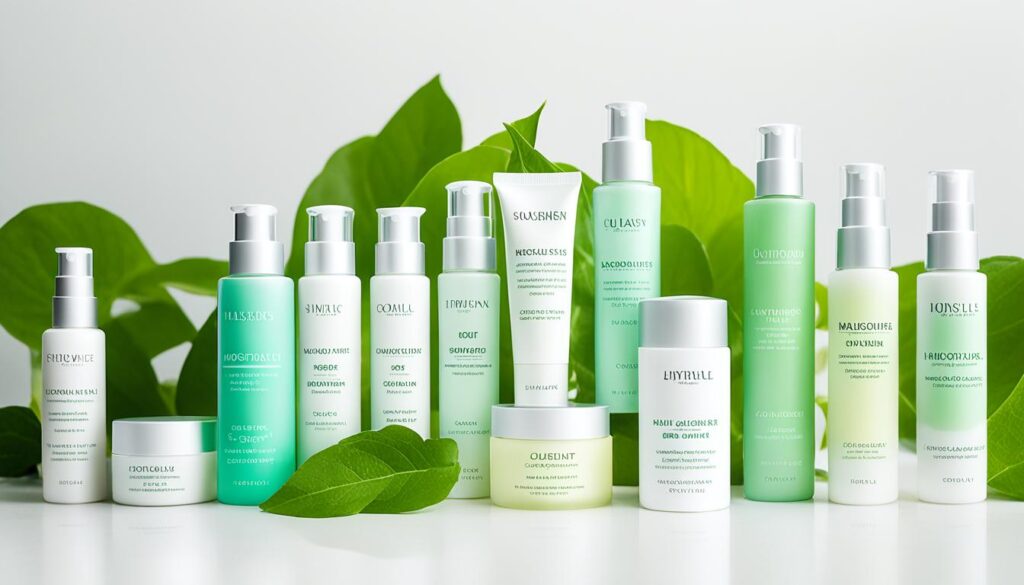
Mattifying Moisturizers
Mattifying moisturizers work great for keeping your face shine-free all day. Look into products such as La Roche-Posay’s Effaclar Mat or Clinique’s Dramatically Different Hydrating Jelly. These keep your pores clear, your skin velvety, and your confidence high, even when it’s sticky outside.
Moisturizers with Salicylic Acid
If you often deal with breakouts, a moisturizer with salicylic acid is a good idea. It keeps your skin moist and fights acne. Neutrogena Oil-Free Acne Moisturizer and Clean & Clear Dual Action are great choices. They’re specially made to fight pimples while still keeping your skin happy.
Lightweight and Hydrating Options
Many people with oily skin like lightweight moisturizers. These need to be non-greasy and hydrating. Check out products like CeraVe Ultra-Light Moisturizing Lotion and the Olay Regenerist Whip. They add moisture and nutrients without making your skin oily.
These top products can help you find the perfect moisturizer for oily skin. They’re made just for that, so getting the right one will make your skin feel and look much better.
DIY Natural Moisturizers for Oily Skin
Making your natural moisturizer for oily skin lets you pick the best ingredients. It’s a fun, money-saving way to keep your skin looking great. You’ll find easy recipes that work well for you.
Common Ingredients
For homemade skincare, we often use easy-to-find natural stuff. Let’s look at essential items that help oily skin look its best:
- Aloe Vera: It calms and moisturizes skin without making it oily.
- Tea Tree Oil: Fights acne and cuts down on oily shine.
- Witch Hazel: This natural product tightens skin and reduces oil.
- Honey: It’s antibacterial and keeps skin hydrated but not greasy.
- Cucumber: Cucumbers do more than refresh your eyes. They’re also a fantastic way to hydrate your skin lightly.
| Ingredient | Benefits | Application |
|---|---|---|
| Aloe Vera | Soothes irritations and provides lightweight hydration | Apply the gel directly or use it in lightweight creams |
| Tea Tree Oil | Antimicrobial, reduces inflammation, prevents acne | Add a few drops to your moisturizer |
| Honey | Antibacterial, balances moisture, soothes skin | Use raw honey as a mask or blend with other moisturizers |
| Cucumber | Hydrates, refreshes, and calms skin | Apply slices directly or use cucumber-infused products |
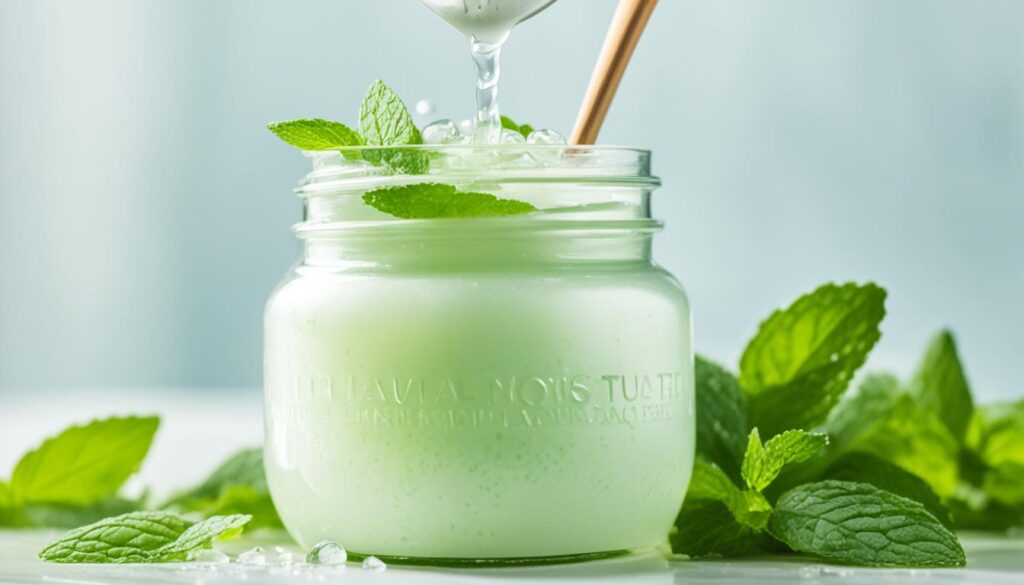
Simple Recipes
Here are some easy recipes to make your natural moisturizers for oily skin:
- Aloe Vera & Tea Tree Moisturizer: Mix 2 tablespoons of aloe vera with 3-4 drops of tea tree oil daily for fresh, oil-free skin.
- Witch Hazel & Honey Moisturizer: Mix one tablespoon of witch hazel with one teaspoon of honey. Apply a little layer and let it soak in.
These recipes use natural elements for moisturizers that fit oily skin. Start making your skincare and see the difference.
Daily Skincare Routine for Oily Skin
Creating the perfect daily skincare routine for oily skin is vital. It requires specific steps in the morning and at night. Doing this can balance your skin, avoiding too much oil while staying bright and smooth.
Morning Routine
Your morning skincare is essential for oily skin. Start with a gentle cleanser to get rid of night oils and dirt. Then, use a toner that doesn’t have alcohol to help your skin keep the right balance. A good, non-comedogenic moisturizer is next. It hydrates without blocking your pores.
Don’t skip the sunscreen, too. Pick an oil-free, mattifying one with SPF 30 or more. This step protects you from the sun’s harmful rays without making your skin more oily.
Evening Routine
In the evening, you can do more for your oily skin. Start by taking off your makeup with a gentle remover. Then, clean your face well with a good face wash. This gets rid of all the dirt and oils.
After that, use a toner to prepare your skin for the next steps. Apply a serum designed for acne or large pores, like one with salicylic acid. Finish with a light, oil-free moisturizer for the night. It helps your skin stay hydrated and fresh while you sleep.
| Step | Morning Routine | Evening Routine |
|---|---|---|
| 1 | Cleanser | Makeup Remover & Cleanser |
| 2 | Toner | Toner |
| 3 | Moisturizer | Serum |
| 4 | Sunscreen | Night Moisturizer |
Layering Products: Order Matters
Getting the correct order for skincare products is vital. It boosts the benefits of your skincare routine. If you have oily skin, the proper order can change how your skin looks and feels.
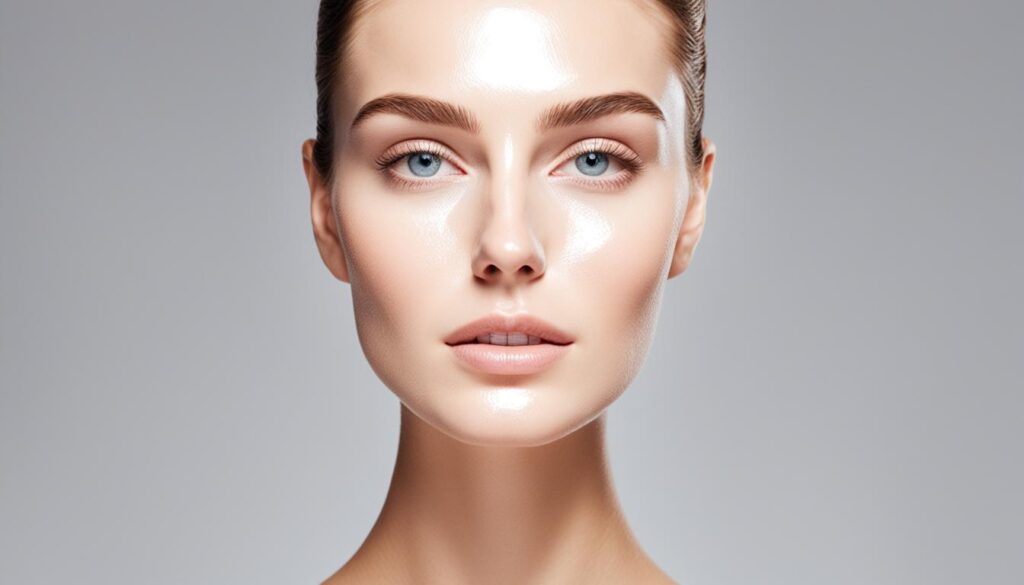
Serums Before Moisturizers
Facial serums are potent, sending essential ingredients deep into your skin. They’re best applied before moisturizer, so the good stuff in serums absorbs well. They’re light but work hard, offering hydration, glow, and fighting signs of aging. Start with clean, toned skin, then apply your serum for the best results.
Sunscreen After Moisturizer
In a daily routine, sunscreen should be the last product applied. It goes on after your moisturizer. This helps create a barrier against UV rays. Not only does it keep your skin safe from the sun, but it also protects other products from sun damage. This keeps your skincare routine effective, even in sunlight.
Here’s a quick guide for reference:
| Step | Product | Purpose |
|---|---|---|
| 1 | Cleanser | Clears away impurities |
| 2 | Toner | Balances skin pH |
| 3 | Serum | Deliver active ingredients |
| 4 | Moisturizer | Hydrates and locks in moisture |
| 5 | Sunscreen | Protects against UV rays |
Hydration Without the Shine
Getting your skin hydrated without looking shiny can be tricky, especially with oily skin. But with the proper steps, it’s doable. We will explore ways to keep your skin looking hydrated yet oil-free.
Using Gel-based Formulas
Gel moisturizers for oily skin are great for hydration without the shine. They are light, absorb fast, and give your skin moisture without feeling greasy. Choose products that have hyaluronic acid and glycerin. These help hydrate your skin but won’t block your pores.
Blotting Papers and Powders
For a matte look all day, use oil-absorbing products like blotting papers and powders. Blotting papers are perfect for quick fixes, soaking up oil without ruining your makeup. Oil-absorbing powders can instantly give you a matte look and are suitable for everyday makeup. Pick ones that don’t clog your pores and have a lasting effect.
| Product | Benefit | Key Ingredients |
|---|---|---|
| Hydro Boost Water Gel | Hydration without greasiness | Hyaluronic Acid, Glycerin |
| Blotterazzi® by Beautyblender® | Compact and reusable | Polyurethane foam |
| Infallible Pro-Matte Powder | Matte finish techniques | Perlite Mineral Technology |
Addressing Common Concerns and Issues
Many people deal with oily skin, which can bother them daily. Understanding your skin and knowing what to do about it is essential.
Problems like too much shine, big pores, and makeup that doesn’t last are common. But there are ways to handle these issues.
To reduce shine, wash your face often and use products that soak up oil. If you have big pores, use salicylic acid to clean them out.
For makeup to stay put, pick oil-free products that are made to last. Let’s break down these common oily skin issues and how to fix them:
| Common Concern | Suggested Solution |
|---|---|
| Excessive Shine | Use mattifying primers and setting powders. |
| Enlarged Pores | Incorporate products containing salicylic acid. |
| Makeup Longevity | Opt for oil-free, water-resistant makeup options. |
Working on these beauty concerns regularly can keep your skin looking good. Remember that finding what works is an ongoing task. But with the proper steps, you can stay on top of oily skin problems.
Common Mistakes to Avoid When Applying Moisturizer for Oily Skin
Adding moisturizer to oily skin might feel strange, but it’s vital for good skin. However, there are some critical mistakes to avoid. Knowing these errors will help you enjoy the full benefits of using moisturizer.
Over-Moisturizing
Piling on moisturizer is a big mistake for oily skin. Too much can make your skin lazy in producing moisture, leading to a destructive cycle of over-moisturizing. Try to keep it balanced to avoid this issue.
Using Heavy Products
Choosing the wrong type of moisturizer is another common problem. Heavy, oil-based ones make oily skin even greasier. Go for light, non-comedogenic moisturizers. They keep your skin looking matte and healthy.
Applying on Dirty Skin
Putting on moisturizer without cleaning your skin first is a big no. It can lock in dirt and bacteria, causing pimples. Always wash your face well before applying moisturizer. This way, your skin can absorb it better without getting blocked.
Steer clear of these mistakes, and your care for oily skin will significantly improve.
Choosing an Oil-Free Moisturizer
Finding the perfect oil-free moisturizer for oily skin is vital. It can help keep your skin moist while avoiding excess shine and breakouts. These unique products are made to moisturize your skin without making it feel greasy.
Benefits of Oil-Free Products
If you have oily skin, using an oil-free moisturizer is very beneficial. It can control shine, leaving your skin with a smooth look all day. These moisturizers contain hyaluronic acid or glycerin, which hydrates without blocking pores. Using these lowers the chance of getting breakouts from heavy, oily moisturizers.
Top Recommendations
Some oil-free skincare products genuinely shine. Let’s take a look at a few recommendations:
- Neutrogena Hydro Boost Water Gel is a top choice for oil-free hydration. Its hyaluronic acid provides a light, moisturizing touch.
- La Roche-Posay Effaclar Mat: Perfect for oily skin, this product reduces shine, hydrates, and makes pores look smaller.
- Cetaphil PRO Oil Absorbing Moisturizer: It controls oil and has SPF for sun protection. It is ideal for everyday use.
Moisturizer for Oily Skin: Does Makeup Affect It?
Finding the correct makeup for oily skin might be challenging, but it’s not impossible. With the correct items and methods, you can look perfect. This is true, especially when discussing makeup and moisturizers for oily skin.
Choosing the Right Primer
The first step is picking the right makeup primer. A good primer can help control oil and keep your makeup put all day. Look for ones that say they are “mattifying” or “pore-minimizing.” They are great for managing oil. A primer with salicylic acid can also prevent breakouts. It’s the key to having smooth makeup if you have oily skin.
Setting Sprays
Many forget about setting sprays, but they’re essential. They seal in your makeup and help prevent it from looking oily. The best setting spray has a matte finish. It hides oil and shines, ensuring your makeup looks fresh all day.
Benefits of Regularly Updating Your Skincare Routine
Updating your skincare regimen is critical to keeping your skin healthy and bright. By checking and changing your products often, you ensure they work well for your skin’s needs.
Seasonal Changes
Your skin reacts differently as the seasons change. Here are some tips for each season:
- Winter: Cold winds can make your skin dry. Try using a heavier moisturizer.
- Summer: More humid air might cause oily skin and breakouts. Lighter products could help.
Each season has its hurdles, so tweaking your skincare routine is essential. It helps keep your skin’s health in check.
Skin Getting Used to a Product
After a while, your skin might get used to your skincare items. This can lower their impact. Changing things up regularly ensures your routine keeps working well. This offers several benefits:
- It keeps your skin from getting bored, as it needs something new over time.
- It helps new products work better by targeting specific skin issues.
Updating your skincare routine helps maintain your skin’s glow and keeps it responding well to treatments.
The Role of Diet in Skin Health
Eating right can hugely impact your skin. It can make your skin more transparent and control how much oil it produces. Adding certain foods and cutting out others can get better, healthier skin.

Foods to Eat
What you eat matters for your skin’s look. Here are essential foods that make your skin clear:
- Leafy greens: Spinach, kale, and others have lots of vitamins for your skin.
- Fatty fish: Fish like salmon have omega-3s that fight inflammation.
- Nuts and seeds: Almonds and flaxseeds contain healthy fats and antioxidants.
- Berries: Berries are full of skin-saving antioxidants.
- Whole grains: Foods like brown rice and oats can balance your blood sugar and stop your skin from getting too oily.
Foods to Avoid
But not all foods are suitable for the skin, especially if it’s oily. Here’s what to stay away from:
- Sugary foods: Sweets and sodas can make skin oilier and cause breakouts.
- Dairy products: Items like milk and cheese can mess with your hormones, making your skin oilier.
- Fried foods: Fried treats make your skin produce more oil.
- Processed snacks: Chips have too much salt and bad fats, hurting your skin.
- High glycemic index foods: Eating foods like white bread may make your skin more oily and prone to breakouts.
Watching what you eat is crucial for skin health. It’s not just about washing your face or using lotions. Think about how your diet might affect your skin, especially if it’s oily. If you eat foods that are good for clear skin, you’ll see your skin improve over time.
Importance of Patch Testing New Products
Patch testing skincare products is crucial for your skin’s well-being. It helps avoid bad reactions and finds irritants early. We will show you how to do a patch test correctly and find potential skin troublemakers.
How to Patch Test
Doing a patch test right can prevent you from getting skin irritation. Here’s what you need to do:
- Choose a place like behind your ear that’s hidden.
- Put a tiny bit of the product on this spot.
- Put a bandage over it to keep it from rubbing off.
- Wait 24 to 48 hours and watch for any bad reactions.
- Look for redness, itching, or swelling as signs of a response.
Identifying Irritants
Finding what’s terrible for your skin can be challenging but vital. Follow these tips to help spot potential issues:
- Examine Ingredients: Search for fragrances, preservatives, and dyes that could cause allergies.
- Monitor Reactions: Notice any lousy skin reactions immediately or even a bit later after using a product.
- Keep a Log: Write down your patch test results and notice any repeating patterns over time.
By following these steps, you can do a good product allergy test. You’ll keep harmful things from your skincare and protect your skin from unknown dangers. A proper patch test can keep your skin healthy and free from unwanted troubles.
Conclusion
Skincare for oily skin is about finding the right moisturizer and using it properly. Knowing your skin type, picking the right products, and sticking to a routine are vital. This guide has shown you why this matters.
Learning about oily skin and how to care for it is essential. We have covered what to look for, common myths, and practical tips. Staying hydrated, picking the right products, and using them correctly help keep your skin clear and balanced.
The path to glowing skin isn’t scary if you follow these steps. Manage your oily skin by using the proper skincare every day. Keep your skin well-moisturized and avoid blemishes. Stay consistent and make intelligent choices for healthy skin.




